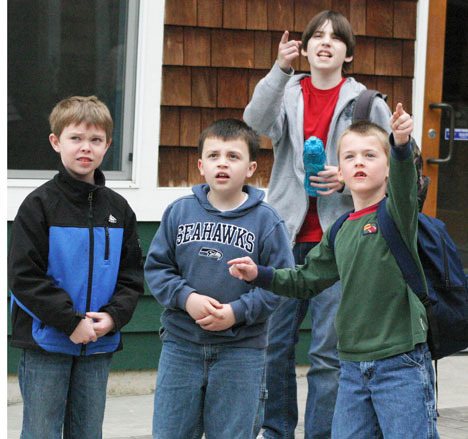LANGLEY — South Whidbey public and private schools are a study in contrast.
While the public system grapples with the financial woes caused by a 10-year slide in overall enrollment, the private sector has the opposite problem.
“We’re almost at capacity, so my problem is, do we expand here or move elsewhere?” said Island Christian Academy director Karen Norton.
Three years ago, the school — started in 1990 by a group of parents who wanted a Christian education for their children — had roughly 30 students enrolled in pre-kindergarten through the 12th grade.
Today, that number has more than tripled to 101, and represents 70 elementary children and 31 kids in junior and senior high school.
The school rents its buildings from South Whidbey Assembly of God on Maxwelton Road in Langley but otherwise is non-denominational and independent.
“We have children attending from a lot of religions,” Norton said. “We’ve found that some parents are dissatisfied with what the public schools offer and were looking at other options. We are one of those options.”
She noted that ICA is a classical school and the curriculum is focused on college-bound students.
One of those formerly dissatisfied parents is Gina Helmerson, who has a daughter, 9, in third grade and a son, 10, in the fifth.
“The main reason I took them out of the public system is that the classes are too large at South Whidbey Elementary School,” Helmerson explained. “The teachers can police the students, but not teach.”
She added that her son wasn’t getting the attention he deserved and now is getting excellent grades.
“And my daughter was being bullied on the playground over there,” Helmerson added. “I put a stop to that, but I don’t want it to ever happen again. The academy is smaller, teachers can keep track of everything going on. Strict discipline is maintained and no put-downs or bullying is tolerated.”
Helmerson said she’s more than willing to pay the $714 per month it costs for both students to attend a private school.
“I’m impressed with the quality of education they provide. My daughter is taking an after-hours class in Latin,” she noted.
Picking up his children at day’s end on Monday — sons Brighton and Keenan — father Chris Schott echoed Helmerson’s views, though he still commits financially to the public system’s future.
“My wife and I supported the South Whidbey School District, and have from day one by voting for both bonds and levies that are on the ballot,” he said. “We want the district to flourish and succeed and remain an option to all South Enders.
“But we like the small classroom size and the one-on-one teacher-student interaction at ICA and feel that it is a great learning environment,” he said.
Regardless of the direction taken by the academy to deal with its increasing student population, some things will remain the same, school officials said.
“We reinforce basic family values, provide high academic standards and have teachers that are loving and supportive to each student,” Norton said. “We believe success with our students comes from our low student-to-teacher ratio, strong academic curriculum and our Christian environment.
“That’s not going to change.”
Other private schools on central and South Whidbey include the Cedar Program in Coupeville, Whidbey Island Waldorf School and the Wellington Day School.
Waldorf School administrator Maureen Marklin said her school’s enrollment suffered a small decline two years ago, but has bounced back. The school is home to 112 students, nursery through the eighth grade.
“We are stable and growing and our projection is for increasing enrollment next year,” Marklin said.
Meanwhile, the search for a solution to the public school district’s budget deficit continues.
At 6:30 p.m. Wednesday, the South Whidbey School Board will hold another workshop on the matter. Business manager Dan Poolman will discuss the processes involved in dealing with the estimated $1.5 million to $1.8 million shortfall next year.
“I’ll be giving a ballpark number, based on what the state Legislature does this week, that paints a picture of where we are,” Poolman said. “If we get this much money, we can do this; that much, we can do that.”
One thing is certain, however. On Thursday, April 15, the initial reduction-in-force notices will be sent to district teachers, letting them know they may not have a job in the fall. Final RIF notices are sent out on May 15.
Helmerson said that, though she has great respect for District Superintendent Fred McCarthy, she doesn’t understand why, if the district plans to close Langley Middle School by the fall of 2012, they don’t sell it.
“That would close the budget gap a bit, right?”



